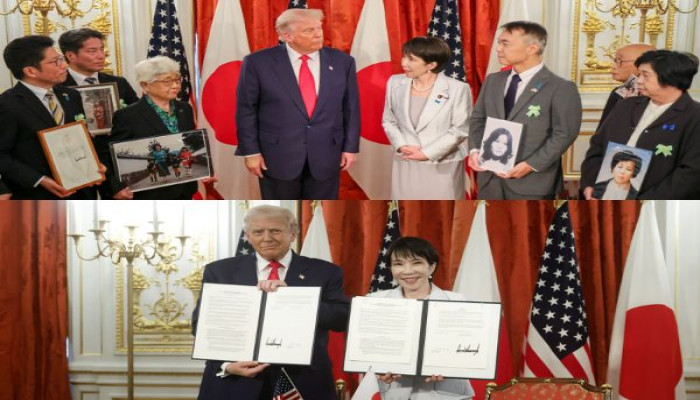Japan, US sign agreements on critical minerals, nuclear reactor to cut dependence on China
- In Reports
- 07:49 PM, Oct 28, 2025
- Myind Staff
Japan and the United States have agreed to work closely on new-generation nuclear reactors and rare earth resources as both countries seek to reduce their dependence on China and strengthen their control over key technologies. The partnership also marks Japan’s attempt to revive its role in the global nuclear export market.
On Tuesday, U.S. President Donald Trump and Japanese Prime Minister Sanae Takaichi signed a framework agreement in Tokyo to secure a steady supply of rare earths, which are essential for manufacturing cars, smartphones, and fighter jets.
The signing ceremony took place at the grand Akasaka Palace, where the two leaders put their signatures on the documents under glittering gold chandeliers, while aides applauded.
Although China was not mentioned directly, both countries share concerns about Beijing’s growing influence. China currently processes more than 90 per cent of the world’s rare earths and has tightened export restrictions in recent months.
Trump and Chinese President Xi Jinping are expected to meet on Thursday during the Asia-Pacific Economic Cooperation summit in South Korea to discuss a possible deal that could pause the rise in U.S. tariffs and China’s export controls on rare earths.
According to a White House statement, Japan and the United States will use joint investments and economic policies to promote "development of diversified, liquid, and fair markets for critical minerals and rare earths".
The statement also said both countries aim to provide financial support to selected projects within six months and explore joint stockpiling and partnerships with other countries to ensure stable supply chains.
Eurasia Group data shows that while China dominates rare earth production, the United States and Myanmar control about 12 and 8 per cent respectively, while Malaysia and Vietnam manage smaller shares of the processing.
Japan’s factsheet for the meeting noted mutual interest in collaborating on advanced nuclear technologies, including AP1000 reactors and small modular reactors.
Major Japanese companies such as Mitsubishi Heavy Industries and the Toshiba Group are likely to take part in these projects.
For Prime Minister Takaichi, who became Japan’s first female prime minister last week, strengthening nuclear power is central to ensuring energy security, affordable electricity, and technological leadership for Japan.
After the Fukushima Daiichi disaster in 2011, Japan shut down all its nuclear reactors, and countries like China, France, South Korea, and Russia went on to dominate global nuclear exports.
The White House also highlighted fusion energy as another area of potential cooperation, an initiative strongly supported by Takaichi.
About 20 companies from Japan and the United States have already expressed interest in joint projects that are part of a planned $550 billion investment package.
However, the joint statement did not include details on new U.S. LNG deals or upstream energy projects involving Japanese companies, which have been growing in recent years.
Before Trump’s visit to Asia, the U.S. had urged countries buying Russian energy, including Japan, to stop imports and imposed sanctions on Russia’s largest oil producers, Rosneft and Lukoil, to pressure Moscow over the Ukraine war.
Japan has since increased LNG imports from the U.S. to diversify away from Australia and prepare for the end of its supply contracts with Russia’s Sakhalin-2 project, which Mitsui and Mitsubishi helped establish in 2009.
In June, JERA, Japan’s largest LNG importer, signed a 20-year deal to buy up to 5.5 million metric tons of U.S. LNG annually starting around 2030, roughly matching the amount it currently imports from Sakhalin-2.
Most contracts from Sakhalin-2, which meet nearly 9 per cent of Japan’s gas needs, will expire between 2028 and 2033.
Currently, Japan imports less than 1 per cent of its oil from Russia under a sanctions waiver that will expire in December. Most of its oil supply continues to come from the Middle East.
Last week, Tokyo Gas signed a preliminary deal to buy 1 million metric tons of LNG annually from Alaska, following a similar announcement by JERA in September.
JERA also invested $1.5 billion in gas assets in Louisiana, marking its first step into upstream production in the U.S., where Tokyo Gas and Mitsui already operate.
A senior Japanese official said that the country plans to continue LNG imports from Sakhalin-2 to keep electricity prices stable, as the Russian shipments take only a few days to reach Japan compared to about a week from Alaska and nearly a month from the U.S. Gulf Coast.
"The U.S. said it wants Japan to stop importing Russian energy - but this is Japan's closest LNG source and is also cheap," said Nobuo Tanaka, chief executive of Tanaka Global, Inc.
"I think the question should be framed this way: Can the U.S. provide Japan with LNG as cheaply as what currently comes from Russia? Can gas from Alaska be that affordable?"







Comments